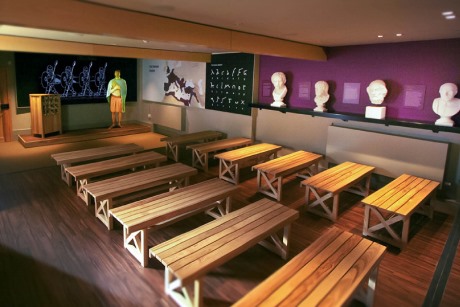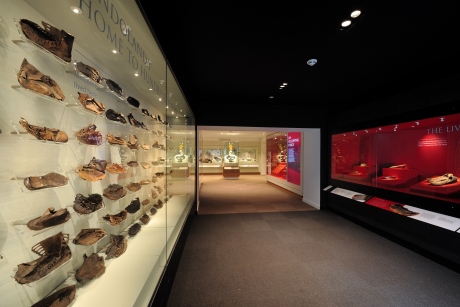The Vindolanda Trust is a charitable trust, which incorporates both Vindolanda Roman Fort and Museum, situated one mile south of Hadrian’s Wall, and the Roman Army Museum, found seven miles to the west.

School Travel Organiser spoke to Lauren Wilkinson, the Vindolanda Trust’s site education officer and museum archaeological assistant, about why a visit to the Roman Army Museum and Vindolanda Roman Fort is educational, engaging and exciting for students.
What activities does the Vindolanda Trust offer for schools?
“At Vindolanda we offer a talk to schools by an archaeologist. This gives the group a good introduction to the site, what there is to see, where and what we are excavating, a chance to see some recent finds, and to start thinking like an archaeologist would.
“If you visit us from the end of March to the end of September the group will also be able to see live excavations taking place, be able to speak to volunteers, and could be witness to something being unearthed that may be nearly 2,000 years old!
“There is also a museum filled with all the artefacts we have discovered, and replica buildings where the group can really get a sense of what life would have been like living here at Vindolanda in Roman times.
“The Roman Army Museum is an interactive indoor museum, which details all aspects of the Roman Army from the material evidence found. Activities here include a 3D film called Edge of Empire, where the group are shown what life for a solider would have been like on Hadrian’s Wall, and a Latin lesson by our holographic teacher, Velius, in our Roman classroom where there is a chance to learn some Latin, amongst other things – as you can’t join the Roman Army without being able to speak Latin!”
What Key Stage is a visit to Vindolanda and the Roman Army Museum targeted to?
“We cater for all age groups and Key Stages at Vindolanda and the Roman Army Museum. The talk by the archaeologist is adapted according to age, and at the Roman Army Museum, groups are never too old, or young, for a Latin lesson or 3D film.”

The Roman Army Museum classroom.
How can a visit be linked to National Curriculum topics?
“There are strong links to National Curriculum subjects and topics at both sites. Obviously the main one is History – the Roman Empire and its impact on Britain. At both sites, schools, through exploring and asking questions, can learn about chronology, the significance of Roman Britain and its culture and beliefs, and make comparisons and interpretations.
“There are links to Latin language at both sites, with downloadable resources to use at Vindolanda and Velius’ lesson at the Roman Army Museum. Both museums will open the group up to other cultures where they will begin to understand and respond to spoken and written language, and communicate ideas, facts and feelings.
“English can be enhanced through students communicating their ideas and emotions, acquiring a wider vocabulary, developing comprehension skills and decoding, as well as justifying answers and considering and evaluating different viewpoints.
“Through both sites Geography can also be explored, Hadrian’s Wall is a globally significant place where groups can look at diverse places and people, and the human and physical environment of this local landscape.”
What do you believe are the benefits of learning outside the classroom?
“The benefits of learning outside the classroom are huge. It gives the children the ability to experience new environments that they may have never been in before.
“In the classroom, images can be shared and replica objects shown, but nothing compares to actually being in the spot where the Romans lived and getting to see close up real artefacts they actually used.
“It provides inspiration that can then be taken back to the classroom and gives a much higher engagement level. Learning outside the classroom caters for all learning styles and needs and is a way to have access to professionals in their field of expertise, providing opportunities for questions which normally could not be asked, or answered. It is an invaluable experience.”
Does a visit to Vindolanda and the Roman Army Museum provide any benefits beyond curriculum learning?
“A visit can provide other benefits to pupils, such as inspiring their curiosity while looking at the Roman artefacts, team work to find answers to resource questions, and building confidence to speak to archaeologists and volunteers and asking them questions.
“We are also an Arts Award Supporter, meaning we can provide support to schools who are involved in the Arts Award at any level.”

The Vindolanda Museum.
How can the knowledge learnt as part of the visit be taken back and used in the classroom?
“If the visit to our sites is at the start of the topic it is a great introduction, it gets the group inspired and engaged and wanting to learn more.
“Mid-topic, the visit can test what they already know and increase their knowledge and understanding.
“A visit at the end of a topic can be a way to celebrate how much they have learnt and get any unanswered questions asked.”
Do you provide schools with any resources to use before, during or after the visit?
“Most of our resources for both sites can be downloaded for free from our website www.vindolanda.com. These resources will enable the group, whatever their ages, to explore the sites and find out more about them in a loosely structured way. Answer sheets for teachers are also available.
“Our Junior Guide Book, and Key Stage 2 and 3 teacher packs, which can be purchased before, during or after a visit, can give a much more detailed and structured aspect to the trip.
“There are fun learning activities downloadable for free for pre- and post-visit use, as well as a junior fun book that can be purchased.
“At the Roman Army Museum we also have a free post-visit activity scroll, which can be taken back to school providing post-visit activity ideas.”
Have you noted a particular activity that is most popular amongst students?
“At Vindolanda, our archaeologist talks are very popular. Groups with over 15 people automatically receive this free talk. It is a great way to find out about the site, the excavations and see some recent finds. Paired with then visiting the live excavations (from March to September), it is a thoroughly engaging experience.
“At the Roman Army Museum the 3D film and holographic teacher are a must-see. The film gives the group a fun and interactive journey through life on Hadrian’s Wall when the Romans occupied it, and the holographic teacher provides an action packed Roman lesson with a remarkable magic blackboard.”
In your opinion what makes a memorable school trip?
“I think a memorable trip for a child has to be exciting, where they can see new things, touch new things, be amazed and be eager to learn more when you get back to class.
“A teacher judges a memorable school trip on how much the group couldn’t stop talking about it on the bus back, and days after.
“We judge it on how amazed their faces are when they are shown a 1,800 year old child’s shoe, and how many ‘wows’ are heard when they walk around the museum!”
For more information call the Roman Vindolanda on 01434-344277 or the Roman Army Museum on 01697-747485, or visit www.vindolanda.com.










